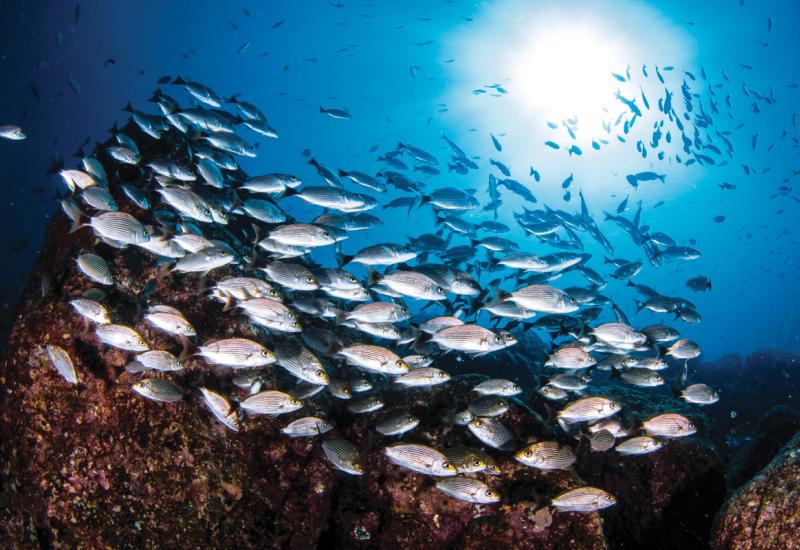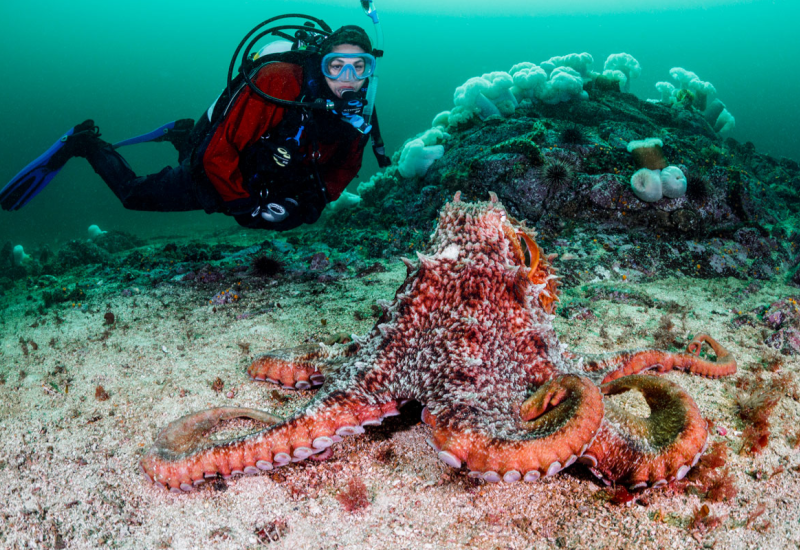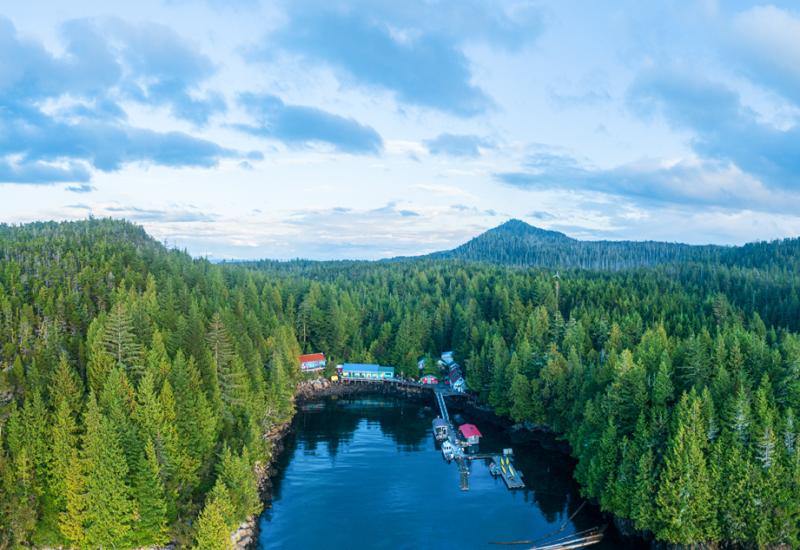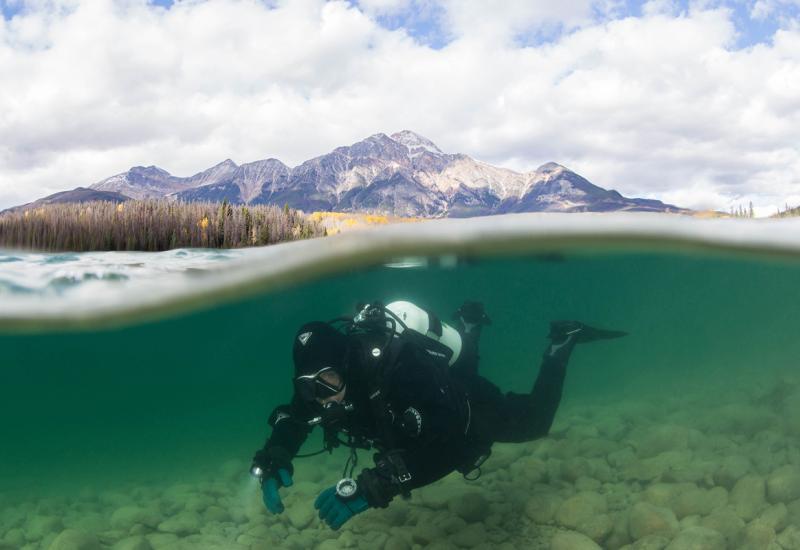Deep in God's Pocket
 |
November 2001
Text and Photography by Glen Ostle
British Columbia is not usually the first destination that comes to mind when divers are looking to get wet. The water is cold, the currents strong and visibility moderate at best. But for those willing to endure such hardships, the reward is an array of marine sights unparalleled anywhere else in the world. Where else can you find pods of orcas, white-sided dolphins and sea lions, and a seafloor covered with brilliantly colored corals and anemones?
For warm-water divers, the prospect of jumping into frigid water, fumbling with dry suits, thick hoods, gloves and weight belts as heavy as boat anchors may seem like more trouble than it's worth. But that thought may quickly change with a single plunge into the waters around God's Pocket, an idyllic cove on British Columbia's Hurst Island. The scenery and critters are so unlike anything you are familiar with that it is like diving again for the first time.
Hurst Island is 500 wooded acres on the northern tip of the Queen Charlotte Strait. It's part of the God's Pocket Provincial Marine Park, which exists to protect seabird nesting sites, bald eagle habitat and several archaeological sites.
The scenery--above and below water--is simply breathtaking, and just getting there can be an adventure. After flying to Seattle we drove to Vancouver and caught a ferry to Vancouver Island. From there we drove five hours north to Port Hardy on the northernmost tip of the island, through scenery that grew more rugged and imposing with each mile. In Port Hardy we met Bill Weeks and Annie Ceschi, owners of God's Pocket Resort, for the 10-mile boat ride through the wilds of Queen Charlotte Strait.
The resort consists of rustic cabins perched on the lip of a protected bay that fishermen used for natural shelter as far back as the early 1900s. After hours of working the rough waters of the strait, fishermen would row their boats, laden with fish, to the calm waters of the cove they named "God's Pocket." For divers, the cove serves a similar function, as a jumping-off point for the famous sites of the area, including legendary Browning Wall.
The Dive Drill
It is hard to describe B.C. diving to anyone who has not experienced it. The cold, nutrient-rich waters are so green that the entire area is referred to as the Emerald Sea. This thick, cold soup produces marine life so immense and prolific that underwater life grows in mounds--fish atop shells containing crabs sitting next to barnacles combing the water for food. Huge anemones, urchins and an incredible array of starfish are everywhere. Gigantic white plumose and brooding anemones sprout up from the seafloor, and some walls are so densely covered with soft corals that a dive light transforms them into bright waving blankets of color.
No doubt about it, the water is cold--about 48F at depth in August--and a dry suit is a must. Visibility ranges from 40 to 120 feet, depending on currents and seasons. Most dives involve drifting with powerful currents along the walls that form the bases of islands. The currents here are swift and can change direction in a matter of minutes, so dives are timed to begin at slack tide. It takes an experienced captain to place you in the water at the right place and time. Safety stops are often made by holding on to one of the many stalks of bull kelp that anchor themselves to the bottom and rise up as much as 40 feet to create a green canopy on the surface that filters sunlight and creates shimmering patterns of light.
 |
Favorite Dives
Browning Wall. Considered one of the best wall dives in North America, this site is loaded with color in the form of orange and red anemones, sculpins and nudibranchs. The wall is a deep (250-foot), vertical and current-swept site that is covered with orange and red soft corals, giant Metridium anemones and nudibranchs.
Hunt Rock. A tangle of kelp floating at the surface marks the location of this steeply sloped underwater pinnacle off the north shoreline of Nigei Island. This current-exposed site has the same encrusting growth as Browning Wall but is also home to big rockfish and a famous pair of six-foot wolf eels--Hunter and Huntress. They are very friendly and have been known to swim out to greet divers.
God's Pocket Bay. A dive from the resort's dock is itself an interesting exploration of the area. In as little as 10 feet of water you can find colorful sea stars, nudibranchs and even octopuses in and among the surrounding rocks.
Barry Islet. This colorful wall is inhabited by large orange peel nudibranchs that meander among anemones of every size and color, while kelp beds wave overhead. Fields of gorgonian coral can be found at about 100 feet.
Croker Rock/Themis. Located at the end of Browning Passage, the kelp-covered pinnacle known as Croker Rock also holds the wreckage of the 270-foot freighter Themis. The ship went down in a southeast gale in 1907 and rests in the same nutrient-rich tidal stream that supplies Browning Wall. Its broken ruins are covered with plumose anemones and soft corals. Spaces between the wreckage are home to octopuses, giant ling cod, king crabs and wolf eels.
B.C. Wreck Dives
Thanks to the nonprofit Artificial Reef Society of British Columbia (ARSBC), B.C. boasts the best wreck diving in North America including the freighter GB Church, sunk in August 1991 off Portland Island, and four 366-foot destroyer escorts--the HMCS Chaudiere (Dec. '92), off Kunechin Point; the HMCS MacKenzie (Sept. '95), off Gooch Island near Sidney; the HMCS Columbia (June '96) off Maud Island near Campbell River, and the HMCS Saskatchewan (June '97), off Snake Island near Nanaimo. For more information, visit www.artificialreef.bc.ca.
The ARSBC's current project, the retired Canadian maintenance ship, HMCS Cape Breton, was scheduled to go down off Nanaimo, B.C., in October 2001. At 441 feet long, the vessel is destined to be one of the largest artificial reefs in North America. To help preserve the ship's history for nondivers, the ARSBC has donated the Cape Breton's stern and massive triple expansion engine to the North Vancouver Museum as a permanent display.
 |
B.C. Dive & Travel Savvy
Geography: As Canada's westernmost province, British Columbia boasts 17,000 miles of coastline on the mainland and around Vancouver Island. The rich cold waters flowing between the Island and the mainland offer dive attractions from natural rock pinnacles to modern steel warships. In our 2001 Rodale's Readers' Choice Awards, B.C. earned the award for Best Overall Dive Destination in North America.
Water Conditions: Summer surface temps can hit 60F, but temperatures in the 40Fs persist at depths below 30 feet. Winter temps average in the mid-40Fs. A neoprene or shell-style dry suit is recommended. Visibility ranges from 40 to 120 feet and is best in autumn and winter.
Travel Planner: There are a number of ways to reach Port Hardy, where you can catch a boat to God's Pocket. You can find direct flights into Port Hardy from Seattle, Vancouver or Victoria, or you can drive part of the way and add some interesting stops to your itinerary.
From Vancouver, take the Tsawwassen or Horseshoe Bay ferry boats to Nanaimo on Vancouver Island. There is also a ferry from Victoria, but it adds two hours to the drive. Drive time from Nanaimo to Port Hardy is about five hours. We detoured along the way in Campbell River for some excellent diving in Discovery Pass and on the HMCS Columbia, a 366-foot Canadian destroyer escort sunk as an artificial reef in 1996.
Accommodations: The resort can house 14 divers in two- to four-room lodges with private bathrooms with showers and daily private maid service. Prices include three meals, two boat dives daily and air, plus unlimited shore diving. The resort boasts a "charging wall" for cameras and lights, but does not rent dive gear other than tanks and weights.
For More Info: God's Pocket Resort, (888) 534-8322, (250) 949-1755.
More British Columbia Dive Operators
Abyssal Diving Charters & Lodge (800) 499-ABYS, (250) 285-2420
B.C. Dive Adventures Inc. (604) 983-2232
Beaver Aquatics Ltd. (250) 287-7652
Divers World (604) 732-1344
HideAway at Browning Pass (877) 725-2835, (250) 753-3751
Lowes Resort (877) 883-2456, (604) 883-2456
Ocean Explorers Diving Ltd. (800) 233-4145, (250) 753-2055
Ocean Sports (800) 414-2202, (250) 475-2202
Pacific Pro Dive & Travel (877) 800-3483, (250) 338-6829 (Victoria); (800) 561-3483, (780) 432-1904 (Edmonton)
Rendezvous Dive Ventures Ltd. (877) 777-9994, (250) 720-9306
Rowand's Reef Scuba Shop (604) 669-3483
Six Gill Adventures Ltd. (800) 761-5661, (250) 339-2087
Sunshine Coast Tours (800) 870-9055, (604) 883-2280
The Diving Locker (800) 348-3398, (604) 736-2681
Live-aboards
Clavella Adventures (877) 725-2835, (250) 753-3751
Mamro Adventures (250) 756-8872
Nautilus Explorer / Lever Diving (888) 4-DIVE-BC, (604) 657-7614
Take a dive vacation that counts!
Each year, the Reef Environmental Education Foundation (REEF) coordinates several survey projects. Each project is led by REEF staff and features daily identification seminars and survey dives. REEF Field Surveys are a great introduction to fish identification for novice fishwatchers, and a fun way for experienced surveyors to build their life list while interacting with fellow fishwatchers. In 2002, there are several west coast opportunities--
-
Monterey Bay, April 10-14. Cost is $580 and includes lodging just minutes from Cannery Row at the Monterey Plaza Hotel, diving (three 2-tank AM boat dives and optional shore dive) with the Monterey Bay Dive Center, and 2 breakfasts. We will also be touring the Monterey Bay Aquarium.
-
Channel Islands National Marine Sanctuary, September 17-21, aboard the M/V Conception. Cost of this survey is $430 and includes food, lodging, and diving (up to 15 dives).
-
God's Pocket, British Columbia, September 8-14. Cost is $821 and includes lodging, food, diving (2 boat dives per day, unlimited shore diving), and r/t transportation from Port Hardy. This project will also include invertebrate identification.
Contact Dive Reservations, Inc. at 888-363-3345 or [email protected] for more information and to reserve your spot. To find out more about REEF, visit www.reef.org.
November 2001
Text and Photography by Glen Ostle
British Columbia is not usually the first destination that comes to mind when divers are looking to get wet. The water is cold, the currents strong and visibility moderate at best. But for those willing to endure such hardships, the reward is an array of marine sights unparalleled anywhere else in the world. Where else can you find pods of orcas, white-sided dolphins and sea lions, and a seafloor covered with brilliantly colored corals and anemones?
For warm-water divers, the prospect of jumping into frigid water, fumbling with dry suits, thick hoods, gloves and weight belts as heavy as boat anchors may seem like more trouble than it's worth. But that thought may quickly change with a single plunge into the waters around God's Pocket, an idyllic cove on British Columbia's Hurst Island. The scenery and critters are so unlike anything you are familiar with that it is like diving again for the first time.
Hurst Island is 500 wooded acres on the northern tip of the Queen Charlotte Strait. It's part of the God's Pocket Provincial Marine Park, which exists to protect seabird nesting sites, bald eagle habitat and several archaeological sites.
The scenery--above and below water--is simply breathtaking, and just getting there can be an adventure. After flying to Seattle we drove to Vancouver and caught a ferry to Vancouver Island. From there we drove five hours north to Port Hardy on the northernmost tip of the island, through scenery that grew more rugged and imposing with each mile. In Port Hardy we met Bill Weeks and Annie Ceschi, owners of God's Pocket Resort, for the 10-mile boat ride through the wilds of Queen Charlotte Strait.
The resort consists of rustic cabins perched on the lip of a protected bay that fishermen used for natural shelter as far back as the early 1900s. After hours of working the rough waters of the strait, fishermen would row their boats, laden with fish, to the calm waters of the cove they named "God's Pocket." For divers, the cove serves a similar function, as a jumping-off point for the famous sites of the area, including legendary Browning Wall.
The Dive Drill
It is hard to describe B.C. diving to anyone who has not experienced it. The cold, nutrient-rich waters are so green that the entire area is referred to as the Emerald Sea. This thick, cold soup produces marine life so immense and prolific that underwater life grows in mounds--fish atop shells containing crabs sitting next to barnacles combing the water for food. Huge anemones, urchins and an incredible array of starfish are everywhere. Gigantic white plumose and brooding anemones sprout up from the seafloor, and some walls are so densely covered with soft corals that a dive light transforms them into bright waving blankets of color.
No doubt about it, the water is cold--about 48F at depth in August--and a dry suit is a must. Visibility ranges from 40 to 120 feet, depending on currents and seasons. Most dives involve drifting with powerful currents along the walls that form the bases of islands. The currents here are swift and can change direction in a matter of minutes, so dives are timed to begin at slack tide. It takes an experienced captain to place you in the water at the right place and time. Safety stops are often made by holding on to one of the many stalks of bull kelp that anchor themselves to the bottom and rise up as much as 40 feet to create a green canopy on the surface that filters sunlight and creates shimmering patterns of light.
Favorite Dives
Browning Wall. Considered one of the best wall dives in North America, this site is loaded with color in the form of orange and red anemones, sculpins and nudibranchs. The wall is a deep (250-foot), vertical and current-swept site that is covered with orange and red soft corals, giant Metridium anemones and nudibranchs.
Hunt Rock. A tangle of kelp floating at the surface marks the location of this steeply sloped underwater pinnacle off the north shoreline of Nigei Island. This current-exposed site has the same encrusting growth as Browning Wall but is also home to big rockfish and a famous pair of six-foot wolf eels--Hunter and Huntress. They are very friendly and have been known to swim out to greet divers.
God's Pocket Bay. A dive from the resort's dock is itself an interesting exploration of the area. In as little as 10 feet of water you can find colorful sea stars, nudibranchs and even octopuses in and among the surrounding rocks.
Barry Islet. This colorful wall is inhabited by large orange peel nudibranchs that meander among anemones of every size and color, while kelp beds wave overhead. Fields of gorgonian coral can be found at about 100 feet.
Croker Rock/Themis. Located at the end of Browning Passage, the kelp-covered pinnacle known as Croker Rock also holds the wreckage of the 270-foot freighter Themis. The ship went down in a southeast gale in 1907 and rests in the same nutrient-rich tidal stream that supplies Browning Wall. Its broken ruins are covered with plumose anemones and soft corals. Spaces between the wreckage are home to octopuses, giant ling cod, king crabs and wolf eels.
B.C. Wreck Dives
Thanks to the nonprofit Artificial Reef Society of British Columbia (ARSBC), B.C. boasts the best wreck diving in North America including the freighter GB Church, sunk in August 1991 off Portland Island, and four 366-foot destroyer escorts--the HMCS Chaudiere (Dec. '92), off Kunechin Point; the HMCS MacKenzie (Sept. '95), off Gooch Island near Sidney; the HMCS Columbia (June '96) off Maud Island near Campbell River, and the HMCS Saskatchewan (June '97), off Snake Island near Nanaimo. For more information, visit www.artificialreef.bc.ca.
The ARSBC's current project, the retired Canadian maintenance ship, HMCS Cape Breton, was scheduled to go down off Nanaimo, B.C., in October 2001. At 441 feet long, the vessel is destined to be one of the largest artificial reefs in North America. To help preserve the ship's history for nondivers, the ARSBC has donated the Cape Breton's stern and massive triple expansion engine to the North Vancouver Museum as a permanent display.
B.C. Dive & Travel Savvy
Geography: As Canada's westernmost province, British Columbia boasts 17,000 miles of coastline on the mainland and around Vancouver Island. The rich cold waters flowing between the Island and the mainland offer dive attractions from natural rock pinnacles to modern steel warships. In our 2001 Rodale's Readers' Choice Awards, B.C. earned the award for Best Overall Dive Destination in North America.
Water Conditions: Summer surface temps can hit 60F, but temperatures in the 40Fs persist at depths below 30 feet. Winter temps average in the mid-40Fs. A neoprene or shell-style dry suit is recommended. Visibility ranges from 40 to 120 feet and is best in autumn and winter.
Travel Planner: There are a number of ways to reach Port Hardy, where you can catch a boat to God's Pocket. You can find direct flights into Port Hardy from Seattle, Vancouver or Victoria, or you can drive part of the way and add some interesting stops to your itinerary.
From Vancouver, take the Tsawwassen or Horseshoe Bay ferry boats to Nanaimo on Vancouver Island. There is also a ferry from Victoria, but it adds two hours to the drive. Drive time from Nanaimo to Port Hardy is about five hours. We detoured along the way in Campbell River for some excellent diving in Discovery Pass and on the HMCS Columbia, a 366-foot Canadian destroyer escort sunk as an artificial reef in 1996.
Accommodations: The resort can house 14 divers in two- to four-room lodges with private bathrooms with showers and daily private maid service. Prices include three meals, two boat dives daily and air, plus unlimited shore diving. The resort boasts a "charging wall" for cameras and lights, but does not rent dive gear other than tanks and weights.
For More Info: God's Pocket Resort, (888) 534-8322, (250) 949-1755.
More British Columbia Dive Operators
Abyssal Diving Charters & Lodge (800) 499-ABYS, (250) 285-2420
B.C. Dive Adventures Inc. (604) 983-2232
Beaver Aquatics Ltd. (250) 287-7652
Divers World (604) 732-1344
HideAway at Browning Pass (877) 725-2835, (250) 753-3751
Lowes Resort (877) 883-2456, (604) 883-2456
Ocean Explorers Diving Ltd. (800) 233-4145, (250) 753-2055
Ocean Sports (800) 414-2202, (250) 475-2202
Pacific Pro Dive & Travel (877) 800-3483, (250) 338-6829 (Victoria); (800) 561-3483, (780) 432-1904 (Edmonton)
Rendezvous Dive Ventures Ltd. (877) 777-9994, (250) 720-9306
Rowand's Reef Scuba Shop (604) 669-3483
Six Gill Adventures Ltd. (800) 761-5661, (250) 339-2087
Sunshine Coast Tours (800) 870-9055, (604) 883-2280
The Diving Locker (800) 348-3398, (604) 736-2681
Live-aboards
Clavella Adventures (877) 725-2835, (250) 753-3751
Mamro Adventures (250) 756-8872
Nautilus Explorer / Lever Diving (888) 4-DIVE-BC, (604) 657-7614
Take a dive vacation that counts!
Each year, the Reef Environmental Education Foundation (REEF) coordinates several survey projects. Each project is led by REEF staff and features daily identification seminars and survey dives. REEF Field Surveys are a great introduction to fish identification for novice fishwatchers, and a fun way for experienced surveyors to build their life list while interacting with fellow fishwatchers. In 2002, there are several west coast opportunities--
Monterey Bay, April 10-14. Cost is $580 and includes lodging just minutes from Cannery Row at the Monterey Plaza Hotel, diving (three 2-tank AM boat dives and optional shore dive) with the Monterey Bay Dive Center, and 2 breakfasts. We will also be touring the Monterey Bay Aquarium.
Channel Islands National Marine Sanctuary, September 17-21, aboard the M/V Conception. Cost of this survey is $430 and includes food, lodging, and diving (up to 15 dives).
God's Pocket, British Columbia, September 8-14. Cost is $821 and includes lodging, food, diving (2 boat dives per day, unlimited shore diving), and r/t transportation from Port Hardy. This project will also include invertebrate identification.
Contact Dive Reservations, Inc. at 888-363-3345 or [email protected] for more information and to reserve your spot. To find out more about REEF, visit www.reef.org.










